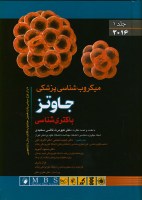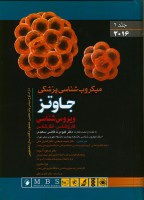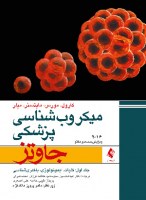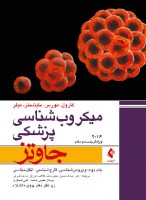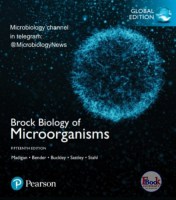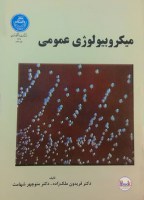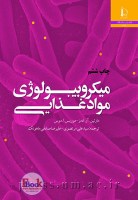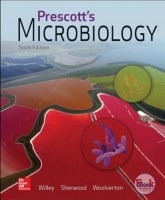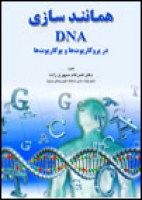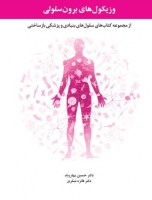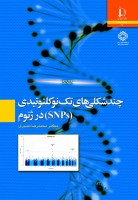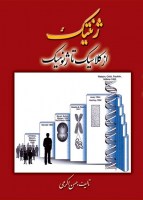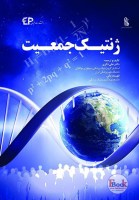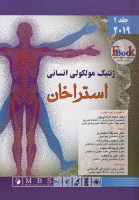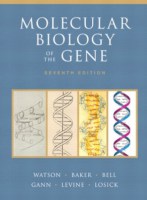دسته بندی
میکروبیولوژی براک جلد دوم
فهرست مطالب:
فصل 13: فتوتروفي، كموليتوتروفي و بيوسنتزهاي اصلي/ فصل 14: كاتابوليسم تركيبات آلي/ فصل 15: بيوتكنولوژي و محصولات تجاري/ فصل 16: تكامل و سيستماتيك ميكروبي/ فصل 17: باکتريها: پروتئوباکتريها / فصل 18: ديگر باكتريها/ فصل 19: آركيها/ فصل 20: زيستشناسي سلول يوکاريوتي و ميكروارگانيسمهاي يوکاريوتي/ فصل 21: تنوع ويروسها/ فصل 22: روشهايي در اكولوژي ميكروبي/ فصل 23: تنوع و زيستگاههاي عمدهي ميکروبي/ فصل24: چرخههاي مواد مغذي، تجزيهي زيستي و زيستپالايي/ فصل 25: همزيستيهاي ميكروبي
میکروبیولوژی مواد غذایی ادمز (فردوسی)
فهرست مندرجات:
فصل1: چشم انداز میکروبیولوژی مواد غذایی
فصل2: میکروارگانیسم ها و موادغذایی
فصل3: عوامل موثر بر رشد و بقای میکروارگانیسم ها در موادغذایی
فصل4: میکروبیولوژی نگهداری موادغذایی
فصل5: میکروبیولوژی محصولات غذایی اولیه
فصل6: میکروبیولوژی موادغذایی و سلامت عمومی
فصل7: عوامل باکتریایی مولد بیماری های ناشی از موادغذایی
فصل8: عوامل غیرباکتریایی مولد بیماری های ناشی از مصرف موادغذایی
فصل9: موادغذایی تخمیری و میکروبی
فصل10: روش های ارزیابی میکروبی موادغذایی
فصل11: کنترل کیفیت میکروبی موادغذایی
فصل12: خواندنی های بیشتر
چندشکلی های تک نوکلئوتیدی در ژنوم (فردوسی)
مطالعه چندشکلیهای تکنوکلئوتیدی (که اصطلاحاًSingle Nucleotide Polymorphism (SNP) یا Snip خوانده میشوند) از مباحث جالب در حوزه ژنتیک مولکولی است. چندشکلیهای تکنوکلئوتیدی رایجترین و گستردهترین حالت تنوع ژنتیکی در انسان و پستانداراناند که بیش از 90 درصد تنوع ژنتیکی را پوشش میدهند؛ لذا، مطالعه آنها از اهمیت ویژهای برخوردار است. حدود 10 تا 12 میلیون SNP در ژنوم انسان وجود دارد که از میان آنها، 50 تا 250 هزار دارای تاثیر بیولوژیک هستند. فراوانی و پراکندگی این گونه چندشکلیها در ژنوم، به کارایی بالای آنها در تمام سطوح منجر شده است. با توجه به اهمیت SNP ها، مطالعه و بررسی بیشتر آنها یکی از وظایف مرکزهای تحقیقاتی و تشخیصی است. اینجانب همراه با همکاران خود در چند سال اخیر تجربههای ارزشمندی در مباحث گوناگون مرتبط با SNP ها در دانشگاه فردوسی مشهد بهدست آوردیم که بسیاری از آن نتایج را بهصورت پایاننامه و برخی را نیز بهصورت مقاله در نشریات معتبر علمی منتشر نمودیم. با توجه به تجربههای ارزشمندی که در این زمینه بهدست آوردهایم بر آن شدیم که در جهت گسترش دانستههایمان درخصوص ژنتیک مولکولی SNP ها، مجموعه حاضر را تالیف و در اختیار محققان این حوزه قرار دهیم.
ژنتیک مولکولی انسانی استراخان 2019 جلد اول (اندیشه رفیع)
بخش اول: اساس DNA،کروموزوم ها،سلول ها،تکوین و وراثت
فصل 1_اصول پایه ای ساختار اسید نوکلئیک و بیان ژن
فصل 2_اصول بنیادی سلول ها و کروموزوم ها
فصل 3_اساس بر همکنش های سلول_سلول و زیست شناسی سیستماتیک ایمنی
فصل 4_جنبه های تکوین اولیه پستانداران،تمایز سلول و سلول بنیادی
فصل 5_الگو های وراثتی
بخش دوم: درک ژنوم
فصل 6_تکنولوژی های DNA هسته ای: تکثیر DNA، هیبریداسیون اسید نوکلئیک و توالی یابی DNA
فصل 7_تحلیل و بررسی ساختار و بیان ژن ها و ژنوم ها
فصل 8_اساس دستکاری ژنتیکی سلول های پستانداران
فصل 9_پرده برداری از معماری و عملکرد های ژنوم انسانی
فصل 10_تنظیم ژنی و اپی ژنوم
بخش سوم: واریانت های ژنتیکی بین افراد و بین گونه ها
فصل 11_مروری بر تنوع ژنتیکی انسان
ژنتیک مولکولی واتسون 2014 زبان اصلی
About the Author
James D. Watson is Chancellor Emeritus at Cold Spring Harbor Laboratory, where he was previously its Director from 1968 to 1993, President from 1994 to 2003, and Chancellor from 2003 to 2007. He spent his undergraduate years at the University of Chicago and received his Ph.D. in 1950 from Indiana University. Between 1950 and 1953, he did postdoctoral research in Copenhagen and Cambridge, England. While at Cambridge, he began the collaboration that resulted in the elucidation of the double-helical structure of DNA in 1953. (For this discovery, Watson, Francis Crick, and Maurice Wilkins were awarded the Nobel Prize in 1962.) Later in 1953, he went to the California Institute of Technology. He moved to Harvard in 1955, where he taught and did research on RNA synthesis and protein synthesis until 1976. He was the first Director of the National Center for Genome Research of the National Institutes of Health from 1989 to 1992. Dr. Watson was sole author of the first, second, and third editions of Molecular Biology of the Gene, and a co-author of the fourth, fifth and sixth editions. These were published in 1965, 1970, 1976, 1987, 2003, and 2007, respectively. He is also a co-author of two other textbooks: Molecular Biology of the Cell and Recombinant DNA, as well as author of the celebrated 1968 memoir, The Double Helix, which in 2012 was listed by the Library Of Congress as one of the 88 books that shaped America.________________________________________
Tania A. Baker is the Head of the Department and Whitehead Professor of Biology at the Massachusetts Institute of Technology, and an Investigator of the Howard Hughes Medical Institute. She received a B.S. in biochemistry from the University of Wisconsin, Madison, and a Ph.D. in biochemistry from Stanford University in 1988. Her graduate research was carried out in the laboratory of Professor Arthur Kornberg and focused on mechanisms of initiation of DNA replication. She did postdoctoral research in the laboratory of Dr. Kiyoshi Mizuuchi at the National Institutes of Health, studying the mechanism and regulation of DNA transposition. Her current research explores mechanisms and regulation of genetic recombination, enzyme-catalyzed protein unfolding, and ATP-dependent protein degradation. Professor Baker received the 2001 Eli Lilly Research Award from the American Society of Microbiology and the 2000 MIT School of Science Teaching Prize for Undergraduate Education and is a fellow of the American Academy of Arts and Sciences since 2004 and was elected to the National Academy of Sciences in 2007. She is co-author (with Arthur Kornberg) of the book DNA Replication, Second Edition.
________________________________________
Stephen P. Bell is a Professor of Biology at the Massachusetts Institute of Technology and an Investigator of the Howard Hughes Medical Institute. He received B.A. degrees from the Department of Biochemistry, Molecular Biology, and Cell Biology and the Integrated Sciences Program at Northwestern University and a Ph.D. in biochemistry at the University of California, Berkeley in 1991. His graduate research was carried out in the laboratory of Dr. Robert Tjian and focused on eukaryotic transcription. He did postdoctoral research in the laboratory of Dr. Bruce Stillman at Cold Spring Harbor Laboratory, working on the initiation of eukaryotic DNA replication. His current research focuses on the mechanisms controlling the duplication of eukaryotic chromosomes. Professor Bell received the 2001 ASBMB–Schering Plough Scientific Achievement Award, the 1998 Everett Moore Baker Memorial Award for Excellence in Undergraduate Teaching at MIT and the 2006 MIT School of Science Teaching Award.
________________________________________
Alexander A.F. Gann is the Lita Annenberg Hazen Dean and Professor in the Watson School of Biological Sciences at Cold Spring Harbor Laboratory. He is also a Senior Editor at Cold Spring Harbor Laboratory Press. He received his B.Sc in microbiology from University College London and a Ph.D. in molecular biology from The University of Edinburgh in 1989. His graduate research was carried out in the laboratory of Noreen Murray and focused on DNA recognition by restriction enzymes. He did postdoctoral research in the laboratory of Mark Ptashne at Harvard, working on transcriptional regulation, and that of Jeremy Brockes at the Ludwig Institute of Cancer Research at University College London, where he worked on newt limb regeneration. He was a Lecturer at Lancaster University, U.K., from 1996 to 1999, before moving to Cold Spring Harbor Laboratory. He is co-author (with Mark Ptashne) of the book Genes & Signals (2002), and co-editor (with Jan Witkowski) of The Annotated & Illustrated Double Helix.
________________________________________
Michael Levine is a Professor of Genetics, Genomics and Development at the University of California, Berkeley, and is also Co-Director of the Center for Integrative Genomics. He received his B.A. from the Department of Genetics at University of California, Berkeley, and his Ph.D. with Alan Garen in the Department of Molecular Biophysics and Biochemistry from Yale University in 1981. As a postdoctoral fellow with Walter Gehring and Gerry Rubin from 1982-1984, he studied the molecular genetics of Drosophila development. Professor Levine's research group currently studies the gene networks responsible for the gastrulation of the Drosophila and Ciona (sea squirt) embryos. He holds the F. Williams Chair in Genetics and Development at University of California, Berkeley. He was awarded the Monsanto Prize in Molecular Biology from the National Academy of Sciences in 1996, and was elected to the American Academy of Arts and Sciences in 1996 and the National Academy of Sciences in 1998.
________________________________________
Richard M. Losick is the Maria Moors Cabot Professor of Biology, a Harvard College Professor, and a Howard Hughes Medical Institute Professor in the Faculty of Arts & Sciences at Harvard University. He received his A.B. in chemistry at Princeton University and his Ph.D. in biochemistry at the Massachusetts Institute of Technology. Upon completion of his graduate work, Professor Losick was named a Junior Fellow of the Harvard Society of Fellows when he began his studies on RNA polymerase and the regulation of gene transcription in bacteria. Professor Losick is a past Chairman of the Departments of Cellular and Developmental Biology and Molecular and Cellular Biology at Harvard University. He received the Camille and Henry Dreyfuss Teacher-Scholar Award, is a member of the National Academy of Sciences, a Fellow of the American Academy of Arts and Sciences, a Fellow of the American Association for the Advancement of Science, a Fellow of the American Academy of Microbiology, a member of the American Philosophical Society, and a former Visiting Scholar of the Phi Beta Kappa Society. Professor Losick is the 2007 winner of the Selman A. Waksman Award of the National Academy of Sciences, a 2009 winner of the Canada Gairdner Award, and a 2012 winner of the Louisa Gross Horwitz Prize for Biology or Biochemistry of Columbia University.
علوم پایه
کتاب های علوم پایه زیست شناسی شیمی فیزیک ریاضی دانشگاهی





